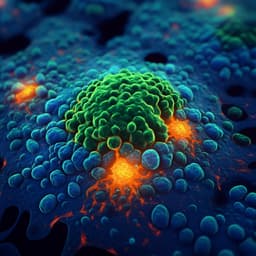
Chemistry
Chemical generation of checkpoint inhibitory T cell engagers for the treatment of cancer
P. A. Szijj, M. A. Gray, et al.
Discover groundbreaking research from Peter A. Szijj, Melissa A. Gray, Mikaela K. Ribi, Calise Bahou, João C. F. Nogueira, Carolyn R. Bertozzi, and Vijay Chudasama, highlighting a cutting-edge chemical method for creating biotin-functionalized checkpoint inhibitory T cell engagers (CiTEs). This innovative approach enhances T cell-mediated cancer cell death more effectively than traditional methods, offering rapid and flexible solutions for multi-protein constructs.
~3 min • Beginner • English
Introduction
The study addresses how to rapidly and modularly generate multispecific protein therapeutics that combine T cell redirection with checkpoint inhibition using purely chemical methods. While bispecific antibodies (bsAbs) and bispecific T cell engagers (BiTEs) can redirect T cells to kill tumor cells, adding a checkpoint inhibitory modality can counter tumor-induced immune suppression. Existing approaches rely largely on genetic/protein engineering; however, chemical bioconjugation offers speed, modularity, and facile incorporation of small-molecule functionalities. The authors aim to develop a Cu-free, bioorthogonal chemical platform to assemble three-protein ‘checkpoint inhibitory T cell engagers’ (CiTEs) from antibody fragments and an immunomodulatory protein, demonstrate construct integrity and function, and evaluate whether checkpoint-modified constructs outperform a BiTE in vitro.
Literature Review
Recent clinical advances have established several bsAbs as anticancer therapeutics. Chemical methods for assembling bsAbs include disulfide re-bridging of Fabs, PEG bis-sulfones, and next-generation maleimides (NGMs), often coupled to SPAAC or related click reactions, but these can suffer from long reaction times, lower yields, and limited downstream functionalization. Pyridazinedione (PD) chemistry enables site-selective disulfide re-bridging and installation of orthogonal click handles; prior work used Br2PD to make Fab–Fab bsAbs and SynAbs (IgG-like constructs using an Fc core) via SPIEDAC between tetrazine and strained alkynes. SynAbs showed incorporation of Fc-mediated properties but lacked further small-molecule functionalization and were limited to Fc-centered architectures. Protein-engineered three- and four-protein CiTEs combining BiTEs with PD-1/PD-L1 blockade demonstrated synergy between checkpoint inhibition and T cell redirection. Additionally, targeted glycan editing using Salmonella typhimurium sialidase has emerged as a strategy to enhance antitumor immunity. However, a general, modular chemical method to build and functionalize three-protein constructs beyond Fc-centered formats has been lacking.
Methodology
Design and chemistry: The platform uses dibromopyridazinedione (Br2PD) reagents to re-bridge the single interchain disulfide in Fabs, installing bioorthogonal handles (tetrazine or strained alkyne, typically BCN). Re-bridging proceeds by sequential thiol addition–elimination displacing bromides to give a stable two-carbon crosslink between heavy and light chains. Bispecific assembly exploits fast, Cu-free SPIEDAC (inverse electron-demand Diels–Alder) between tetrazine and BCN to overcome steric hindrance in protein–protein coupling. An azide handle is included to allow orthogonal small-molecule installation by SPAAC (DBCO–azide), here used for biotinylation.
Construct route: (1) Prepare click-enabled Fabs by Br2PD functionalization. (2) Form a Fab–Fab bsAb (FabY–FabX–N3) via SPIEDAC between complementary BCN- and tetrazine-modified Fabs. (3) Convert bsAb–N3 to bsAb–BCN using a bifunctional BCN–PEG–BCN linker (2) to enable installation of a third protein via SPIEDAC. (4) In situ, add a tetrazine-bearing third protein (either ST sialidase, Sia–Tet–N3, or FabPD-1–Tet–N3) together with DBCO–biotin to simultaneously append the third protein (SPIEDAC) and biotin (SPAAC). Purify by size-exclusion chromatography (SEC) and/or monomeric avidin agarose (for biotinylated constructs). Analytical characterization used SDS–PAGE and LC–MS.
Reaction conditions and examples: Reactions were generally conducted in PBS/BBS at pH ~7–8; sialidase coupling was done at pH 7 to preserve enzyme activity. Representative syntheses and yields included: FabHER2–Sia–biotin (11) from FabHER2–BCN + Sia–Tet–N3 + DBCO–biotin (21% yield; clean after avidin purification). FabHER2–FabCD3–N3 bsAb (13) (24% yield), then SPAAC with DBCO–biotin to give FabHER2–FabCD3–biotin (12) (quantitative after SEC). Dual Cu-free modification demonstrated with FabHER2–(biotin)–FabCD20–biotin (17) via sequential SPAAC and SPIEDAC, though some dimerization (~10%) occurred during BCN–PEG–BCN linkage, mitigated by dilution and excess linker (limited by linker solubility). Three-protein conjugates: FabHER2–FabCD20–Sia–biotin (21) achieved >80% conversion to product (11% overall yield from FabHER2–BCN), confirmed by SEC, SDS–PAGE, LC–MS; FabHER2–FabCD3–Sia–biotin (24) initially co-produced a trispecific FabHER2–FabCD3–FabHER2 (25); purity improved by SEC purification of bsAb intermediate (13) before BCN–PEG–BCN and final coupling, affording clean 24 (20% yield from bsAb–N3 13). A trispecific FabCD3–FabHER2–FabPD-1–biotin CiTE (27) was assembled analogously: bsAb (28) formation and purification, conversion to BCN (29), then SPIEDAC with FabPD-1–Tet–N3 plus DBCO–biotin, giving 27 (12% yield from bsAb–N3 28). In all cases, deconvoluted LC–MS matched expected masses; minor SDS–PAGE artifacts and low-mass contaminants were noted for 27 but major product was confirmed by SEC and MS.
Biological assays: Binding and function were assessed by flow cytometry and enzymatic desialylation measurements. Binding of constructs to HER2+ cell lines (SKBR3, HCC1954, BT-20) and primary T cells (three donors) was quantified, visualized via streptavidin–AF647 binding to biotin. Desialylation on T cells/PBMCs and breast cancer lines (HCC1954, BT-20, MDA-MB-468, SKBR3) was measured using lectin-based detection. T cell–mediated cytotoxicity was tested in co-culture with HER2+ MDA-MB-231 cells (with or without IFN-γ-induced PD-L1), E:T=2:1, 24 h LDH assay; compared non-biotinylated BiTE 30 versus CiTE 24 and CiTE 27 over 0.01–10 nM, with statistics by two-way ANOVA and multiple-comparisons tests.
Key Findings
- Chemical, Cu-free assembly of functionalized three-protein constructs (CiTEs) was achieved using Br2PD disulfide re-bridging, SPIEDAC (tetrazine–BCN) for all protein–protein linkages, and SPAAC for small-molecule (biotin) installation.
- Successful constructs included: FabHER2–FabCD3–Sia–biotin (CiTE 24) and FabCD3–FabHER2–FabPD-1–biotin (CiTE 27), alongside control bsAbs/BiTEs. Yields: e.g., CiTE 24 at 20% from purified bsAb–N3; CiTE 27 at 12% from bsAb–N3; intermediate constructs showed expected masses by LC–MS and purity by SEC/SDS–PAGE.
- Binding: CiTE 24 bound HER2+ targets comparably to BiTE 12 (no significant differences across tested concentrations), but showed reduced CD3 binding on T cells (significant decreases at higher concentrations), likely due to the CD3 Fab being placed in the middle of the tri-protein.
- Enzymatic activity: CiTE 24 induced robust, targeted desialylation—strong on T cells (order-of-magnitude higher than off-target PBMCs) and HER2-dependent on cancer cells (more potent on HER2+ SKBR3, HCC1954 than HER2– BT-20, MDA-MB-468). BiTE 12 had no sialidase activity.
- PD-1 engagement: CiTE 27 exhibited weaker HER2 binding (HER2 Fab placed centrally) and moderately reduced T cell binding overall versus BiTE 12; after CD3 blockade, CiTE 27 retained binding consistent with PD-1 engagement, whereas BiTE 12 binding decreased significantly, supporting functional PD-1 targeting by CiTE 27.
- Cytotoxicity: In T cell–MDA-MB-231 co-cultures (24 h LDH), both CiTEs outperformed BiTE 30 at 0.01–1 nM, with stronger effects when target cells were IFN-γ-treated (PD-L1 upregulation). Statistical examples: For CiTE 24 vs BiTE 30, P=0.0004 at 0.01 nM and P<0.0001 at 0.1–1 nM (untreated); P<0.0001 at 0.01–0.1 nM and P=0.0333 at 1 nM (IFN-γ-treated). CiTE 24 demonstrated about an order-of-magnitude higher activity at low concentrations than BiTE 30 and outperformed CiTE 27, suggesting catalytic desialylation synergizes more strongly with T cell engagement than stoichiometric PD-1 blockade under these in vitro conditions.
Discussion
The work demonstrates that bioorthogonal, Cu-free chemical conjugation can reliably construct homogeneous, functional three-protein immunotherapeutics with built-in small-molecule handles. The constructs retained core functionalities: target binding, T cell engagement (with tunable binding based on Fab placement), and enzymatic checkpoint modulation (desialylation) or PD-1 antagonism. Reduced CD3 binding when the CD3 Fab is centrally positioned may be advantageous by biasing engagement toward tumor cells, potentially lowering systemic activation. In functional assays, both CiTEs exceeded the efficacy of a BiTE control in driving T cell-mediated killing of HER2+ cells, especially under conditions enhancing checkpoint-mediated suppression (IFN-γ/PD-L1 upregulation). The superior low-dose potency of the sialidase CiTE suggests that catalytic glycan removal amplifies T cell activation beyond what is achievable by stoichiometric PD-1 blockade in this setup. Collectively, these findings validate the chemical assembly strategy and indicate the therapeutic promise of combining T cell redirection with enzymatic checkpoint modulation.
Conclusion
A modular, rapid, Cu-free chemical method was established to generate functionalized three-protein constructs (CiTEs) by combining Br2PD disulfide re-bridging with SPIEDAC for protein–protein ligations and SPAAC for small-molecule attachment. Two CiTE archetypes were realized: a sialidase-augmented BiTE (CiTE 24) and a PD-1-blocking trispecific (CiTE 27). Both retained intended activities and outperformed a BiTE in vitro, with CiTE 24 displaying markedly enhanced potency at low concentrations, consistent with catalytic desialylation synergizing with T cell engagement. The approach is generalizable to other checkpoint inhibitors (e.g., CTLA-4, ICOS), cytokines (e.g., IL-2), multi-target selectivity (dual tumor antigens plus CD3), and incorporation of additional small-molecule modalities (fluorophores, toxins, half-life extenders, masks). Future work should optimize Fab placement to balance target and T cell binding, employ PD-L1 targeting where appropriate, incorporate Fc or albumin-based half-life extension, assess in vivo efficacy and safety, and evaluate scalability/developability for industrial translation.
Limitations
- No Fc or alternative half-life extension was included; constructs may have short in vivo half-lives lacking FcRn recycling.
- Purity of some constructs (notably CiTE 27) was imperfect, with minor contaminants/SDS–PAGE artifacts; additional purification and process optimization are needed.
- BCN–PEG–BCN linker exhibited limited aqueous solubility, complicating use in large excess to suppress side reactions (e.g., unwanted dimerization).
- Fab positioned centrally showed reduced target binding—useful for tuning but potentially detrimental depending on target; optimal positioning requires empirical optimization.
- Biological evaluation was limited to in vitro assays (binding, desialylation, short-term cytotoxicity in a single co-culture format and few cell lines); no in vivo data.
- Scalability and manufacturability remain to be demonstrated; multiple purification steps can incur protein losses.
Related Publications
Explore these studies to deepen your understanding of the subject.







